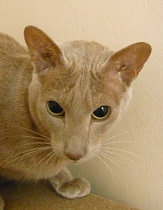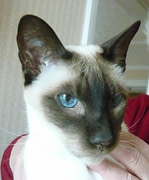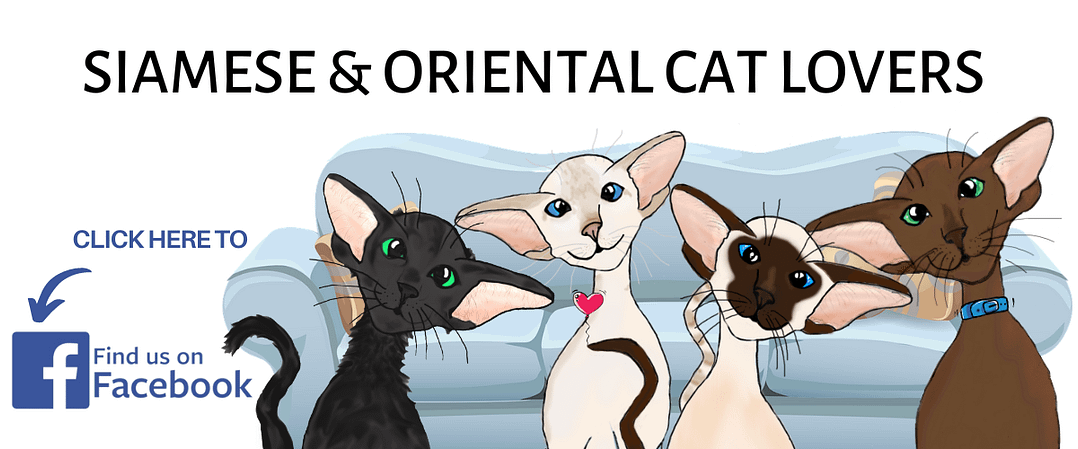My Oriental cat is losing his sight, read the story of Biscuit and help prevent Siamese & Oriental cats from going blind in the future. – Ann Greatorex
My Oriental Cat is Losing His Sight

My Oriental fawn boy is losing his sight. He is six years old.
My first suspicion came when he banged his nose on a litter tray which was temporarily in the middle of the room before it was taken upstairs. Watching him when he was moving about added to my fears. On examination my vet thought Biscuit had PRA and this was confirmed by a vet specialising in eye problems. I was told that if a DNA swab came back normal that could mean he had a previously unrecognised genetic form. Alternatively it could be caused by something else entirely.
[pullquote align=”normal”]His swab came back as homozygous for PRA. That means he has two copies of the faulty gene and he has the condition. [/pullquote]
The ensuing batch of tests on my other cats produced one normal and five carriers. One of Biscuit’s daughters is also homozygous and the biggest shock of all was my newly acquired kitten who is also affected. Until that time, I was prepared to believe the problem might be confined to the cinnamon and fawn lines since Biscuit’s grandmother Mewzishun Sinfonia, and his great grandsire, Sayonara Method Champenois, had both gone blind. (That was ten years ago and, because Sinfo was 8, I was told she was ‘too old’ for PRA.)
[pullquote align=”normal”]My kitten, Bella, has a totally unrelated Siamese sire. That was when the warning bells began to ring. [/pullquote]

Since then, I have persuaded various breeders to test their cats with frightening results. Some of their cats are normal but many are carriers, (meaning they have one copy of the faulty gene) including those from other unrelated pure Siamese lines. Another significant result was that of a chocolate point boy I bred who is just now losing his sight at age thirteen. The expected age range is 3-5 years. (He has tested homozygous.)
It is heartbreaking watching a cat trying to come to terms with sightlessness. At least it is a very gradual deterioration and can, with care, be managed with minimum stress to the cat, but be in no doubt, they exhibit stress. That stress will manifest itself in different ways depending on the individual cat’s temperament.
The chocolate point boy previously mentioned has always been Top Cat and is having real difficulty trying to maintain his position in the household. Fortunately his owner is very understanding and loves him very much but he is changing from a big personality into a clingy fellow.
[pullquote align=”normal”]My Sinfonia sat under a chair most of the time for about three months until her natural confidence began to return. [/pullquote]
My Biscuit has always been gently bullied by the girls he lives with and, although they treat him no worse now he is struggling to see, sometimes he finds it hard to cope with them all. In the summer I noticed his coat did not look ‘right’ even though it was normal when it was smoothed down and he seemed healthy. Now I know what is happening I think it is no coincidence that more recently he also had digestive problems proving difficult to treat when in the past he could eat anything with no ill effect. (He seems much happier now he has come to terms with his problem. His coat is normal, as is his digestion and he does not seem so distressed on the odd occasions he makes a mistake and collides with something.)
It may not be for a long time but a recent study has found retinal degeneration in all homozygous cats examined, so it must be assumed the result will ultimately be total loss of sight if the cat does not die of something else before that time.
[pullquote align=”normal”]I now have the prospect of watching two more cats going blind. [/pullquote]
Spotting the Signs
Cats with this condition can retain a response to light so will often look completely normal in good natural light. ‘In subdued light their pupils become completely dilated and eventually show a ‘green shine’ as they strive to see. This is more obvious in the photos below of the Oriental cat, Biscuit. In Siamese cats, it seems the difference is not so obvious and therefore, in these cats, the physical symptoms could be overlooked. The photos of Lully below show how hard it is to see with a Siamese cat.
Click to enlarge images.
How to Address the Problem
I am glad that so many people approached have realised the gravity of the situation and are seeking to address the problem in different ways.
If everybody tests cats (the test is a very reasonable cost especially if you belong to a breed club qualifying for 20% discount at Langford) and they then act on that information, the spread of this condition can be halted immediately. Breeders already automatically test for Felv/FIV regularly. Testing for PRA involves one test only with a swab taken from cheek cells so there is no need for blood tests or other invasive procedures.
No cat needs to be removed from the gene pool.
Even homozygous cats can still be used for breeding if necessary.
The only rule is that all carrier and homozygous cats MUST be mated to negative cats.
If possible, cats chosen to breed in the next generation should be negative but if not, adhering to the above rule will ensure cats will never be more than carriers.
Please note that carrier cats have no disease. Their eyes show no retinal degeneration.
They will not go blind from this condition.
We need publicity. You can help by discussing it with all breeders and owners of your acquaintance. To anybody who says this is not a widespread problem and is of no concern to them I would say prove it by testing your cats.
[pullquote align=”normal”]Please help by testing your cats and, if you feel able to, publish the results. The situation can then be managed in a way that will ensure no more cats are born destined for the dark. [/pullquote]
I am happy to help answer any questions if I can including how to test your cats. I can supply detailed information from more recent studies not generally available which is relevant to our breeds. If you can provide me with details of the PRA status of your cat/s, in order that the extent of the problem can be determined, I will respect any request for confidentiality, although, of course we hope people will themselves feel able to publish their details.
I am also hoping to explore regimes which may delay the inevitable for affected cats, eg Lutein and other supplements, so please contact me Ann@mewzishun.freeserve.co.uk if you have or need information.





